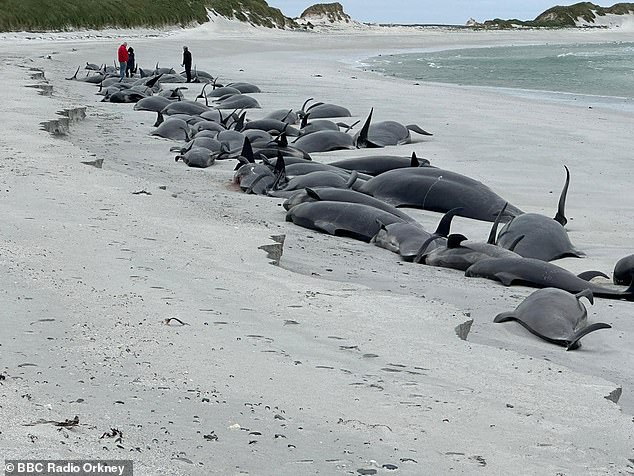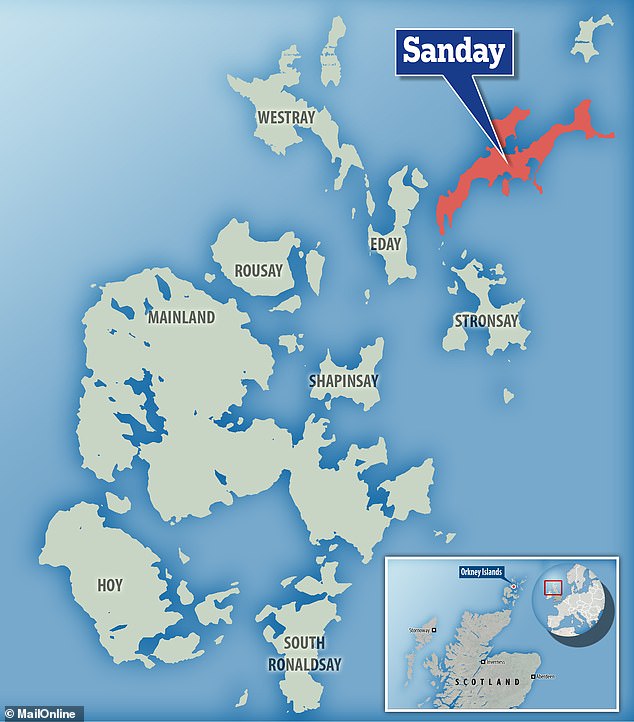Unravelling the mystery of the 77 beached whales in Orkney: Experts reveal the devastating chain of events that could have sparked the biggest mass stranding in Britain for a century
- Twelve survived the initial stranding but were killed after rescue attempts failed
- READ MORE: Why do so many whales end up on Britain's beaches?
It's a tragic and 'heartbreaking' sight – 77 dead whales lined up on the shore at a beach in Orkney.
Described as the biggest mass stranding in Britain for a century, it includes male whales up to seven metres (22ft) long as well as females, calves and juveniles.
It's thought they suffocated by inhaling water from the oncoming tide or had their internal organs crushed by their own weight.
But how did so many of them become beached at once? And why were they driven to shore?
MailOnline spoke to marine biologists and whale experts in an attempt to unravel this devastating mystery at the isle of Sanday.

A tragic sight: MailOnline speaks to marine biologists and whale experts in an attempt to unravel this tragic mystery at the isle of Sanday in Orkney, Scotland
According to experts, the 77 whales are long-finned pilot whales (Globicephala melas), a species found throughout the North Atlantic.
Pilot whales have close social bonds and when one member of a pod gets into difficulties others often follow them, resulting in mass strandings.
One member may have made a navigational mistake or become sick or disorientated, meaning they traveled too close to shore.
'When one family member is sick or injured then the other family members will remain with it,' Dr Kevin Robinson, executive director of the Cetacean Research & Rescue Unit (CRRU), told MailOnline.
'Consequently, the whole group may be prone to strand.;
Because they're an offshore species, pilot whales may not be familiar with inshore coastal features such as tidal races, sand bars and bottleneck harbours.
'[They] may then get caught out by these physical anomalies when they find themselves too close to shore,' Dr Robinson added.

Long-finned pilot whales (Globicephala melas) are one of the most common species to strand in the UK

The mass beaching includes male whales up to seven meters (22ft) long as well as females, calves and juveniles
Ian Wiese, chair of Geographe Marine Research in Western Australia, said pilot whales are often the species involved in these sorts of events.
'They are deep water whales and if they are close to shore it seems to indicate that something is wrong – probably with their navigation as they shouldn't be so close to shore,' he told MailOnline.
'There are a lot of theories as to why this occurs but we don't really know.
'They are very social and form large pods, so when an incident of this nature occurs there are normally a lot of whales involved.'
Mr Wiese added: 'Once they beach themselves it is usually a race against time to save them.
'It has been found that the best approach is to wait until they can all be "relaunched" at the same time – otherwise they often return and beach themselves again.
'However their bodies are not able to support their weight and their internal organs are damaged.'

On 11 July 2024 at about 10:45am, British Divers Marine Life Rescue received a report of a mass stranding of long-finned pilot whales on the isle of Sanday in Orkney

When they were discovered by a member of the public on July 10, 12 of them were still alive and struggling to breathe. But these surviving 12 had to be killed when efforts to return them back to the sea sadly failed, the British Divers Marine Life Rescue (BDMLR) said
Like other whale species, pilot whales emit distinct 'clicks' to sense objects from reflected sound waves – a process called echo-location.
Dr Chong Wei, research associate at Curtin University's Centre for Marine Science and Technology, said human noise pollution could be disrupting this.
'These whales rely on sound for all major life functions and are extremely sensitive to it,' Dr Wei told MailOnline.
'The frequencies of many anthropogenic [human-made] noise sources overlap with the whales' hearing range.
'Those intense noise could cause hearing loss and behavioural changes in these animals.'
Olaf Meynecke, Research Fellow at Griffith University's Coastal and Marine Research Centre, agreed that human triggers may be a factor.
'Once they are in shallow, sandy water they can no longer orientate themselves as they are using very fine tuned sonar,' he told MailOnline.
'The sand absorbs the sonar and the shallow water doesn't allow for it to travel far enough to map the area.
'Pilot whale mass strandings have occurred in similar regions historically but we are seeing an increase that can be attributed to increased stress, changes in environmental conditions, food availability and higher chances of group leaders to become unwell.'
There's also speculation that the whales were chased to shore by orcas ('killer whales'), but it could be a combination of factors.
Dr Capri Beck, a bio-acoustician at Geographe Marine Research, said: 'Another [possibility] is that something caused them to end up in shallow water, be it chasing prey, an interruption to magnetic fields or some sort of event that spooks them.
'When these animals end up close to shore, particularly in shallow sloping areas, their sonar often doesn't work so well and they are not used to waves and currents.
'They may become disorientated and end up stranding.'

Pilot whales use emit distinct 'clicks' to sense objects from reflected sound waves – a process called echo-location (file photo)
When the 77 whales were discovered by a member of the public on July 10, 12 of them were still alive and struggling to breathe.
But these surviving 12 had to be killed when efforts to return them back to the sea sadly failed, the British Divers Marine Life Rescue (BDMLR) said.
'Sadly the remaining 12 pilot whales have been euthanized due to their condition,' said BDMLR in a statement.
It added that they were 'deteriorating from the many hours they have spent stranded on the beach resulting in crush injury from their own weight and the high likelihood that they have inhaled water with the incoming tide'.
Scottish Marine Animal Strandings Scheme intend to begin post-mortem investigations.
Almost a year ago a similar event involving pilot whales occurred on Lewis, another Scottish island located to the west of the mainland, when at least 55 whales died or were euthanised.
A mass stranding also occurred in Western Australia earlier this year.



































































































































































